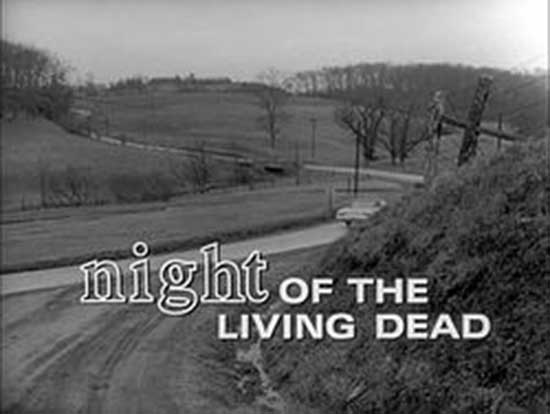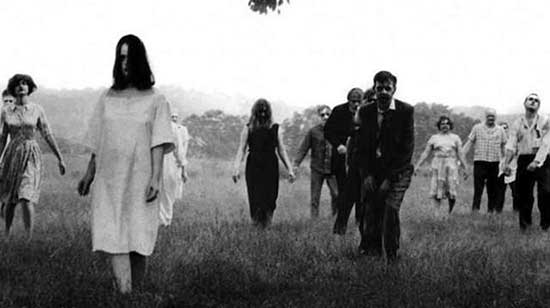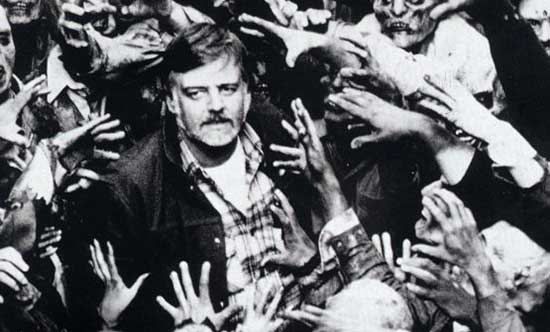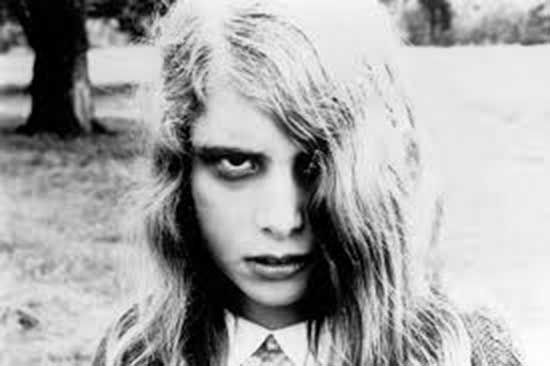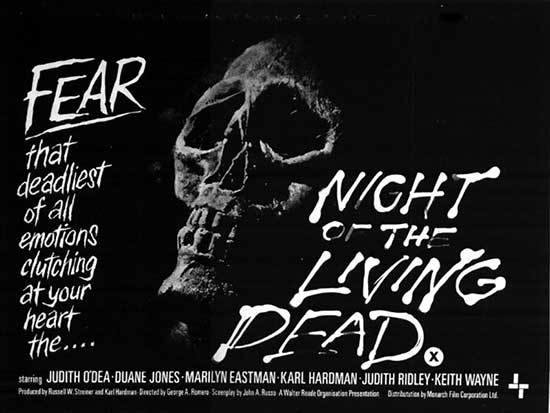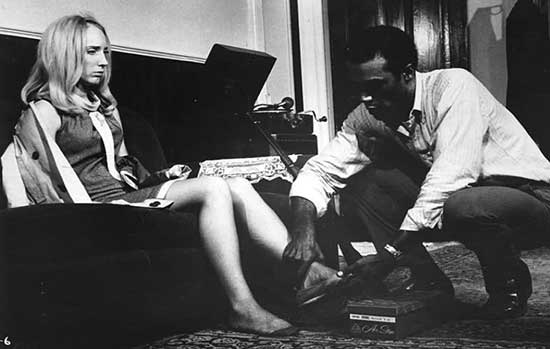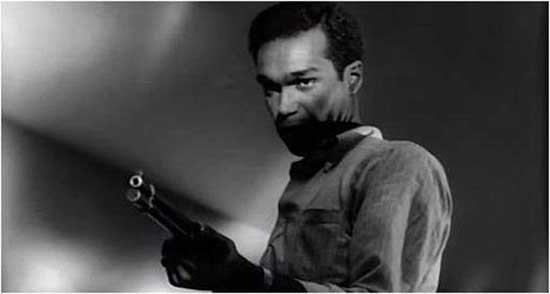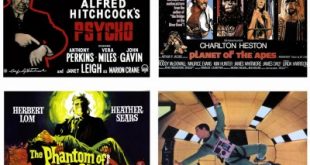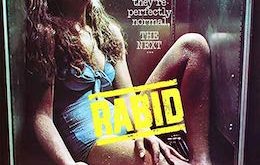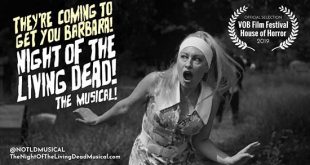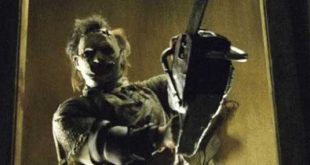Movie: Night of the Living Dead (1968) – Questions and Answers
When anyone in cinema, not just the horror genre, hears or reads the name George A. Romero (RIP) they think of him as the Father of Zombies, and while he didn’t conjure that name for that vicious species, he definitely created a new subgenre, lifestyle and world to scare and explore for countless writers and filmmakers. This Q & A covers in detail the most talked about film of his career Night of the Living Dead (and for this article referred from now on as NOTLD) the fans likely know many of the answers of these questions, but how well do you really know them? Lastly, obviously spoilers given away, and if you’ve never heard or seen of NOTLD, for shame on you and stop here and watch the film, for those who know the movie, be forewarned some controversary finds itself buried but hungry for your curiosity.
Let’s start simple, what is NOTLD about?
Ideally, the audience is swept into the crisis already in progress, but unaware of it, starting with Johnny (Russell Streiner) and Barbara (Judith O’Dea), visiting a grave on Sunday, and after a shocking attack, Barbara flees to the car, later crashing it. Soon enough she hurries to a farmhouse where the main story focuses and involves seven individuals thrust together in a nice little farmhouse with a cemetery nearby, their social dynamics on full display as the undead swarm outside. In the house, Ben (Duane Jones), Judy (Judith Ridley), Tom (Keith Wayne) and the Cooper family consisting of Harry (Karl Hardman), Helen (Marilyn Eastman) and their sick daughter Karen (Kyra Schon). They need to barricade themselves inside, with little supplies, as well as limited information, but a high amount of distrust, anger, resentment and lack of comprise with each other, (all generating a socially impacting film to this day).
Was the storyline of Night of the Living Dead (1968) the original concept?
No, far from it, John Russo and George A. Romero were in vastly different corners, Russo thought of a horror comedy about alien teens visiting Earth meeting with human teens and causing mischief along with a cosmic pet. This first concept rejected not for the story but budget problems, then Russo hatched the story of a boy running await stumbles upon a field of glass, and under it bodies rotting with alien creatures consuming the corpses. The second story also rejected, but the thought of flesh-eating conjured new creations in Romero.
Did the filmmakers use a book for the basis of NOTLD?
Well, technically yes, first the script came from screenwriter Russo and Romero, after many revisions (more on this later), however Romero, years later confirmed and admitted his thoughts of input came from author Richard Matheson’s novel “I Am Legend”. A book originally published in 1954, and one that’s often found in many horror and sci-fi fans’ collections, as it sets the conceptual design of zombie/undead creatures (vampires) conquering the world. The story tells of disease spreading worldwide and creating an apocalypse only spoken in religion, i.e. Revelations and Day of the Reckoning. His book lead to films such as The Last Man on Earth (1964) which starred Vincent Price, The Omega Man (1971), and I am Legend (2007) just to name few.
Did any other filmmakers influence George’s production?
Yes, Herk Harvey’s Carnival of Souls (1962) aided in the design of his picture, however it did create a negative backlash at the time, when he shopped the film around for a distributor with Columbia Pictures interested briefly, yet passed because of the black and white feature, as color became the main focus in the industry. A curious trivia note: Columbia Pictures later released a color version in 1990. In addition, George choose a hopeless fate conclusion for the movie, showing more of a human loss, which lost the interest of AIP (American International Pictures) who sought a reshoot of the ending with an upbeat feeling and deeper love story.
What causes the dead to reanimate?
While Romero never gave any direct or simple answer to this except to sit grinning like the cat that ate the canary. Many of the fans, try to explain it all, with their theories, here are some of those. First, the radiation from a satellite reactivates the brains of the recent dead, this comes the concept of the experts on the television broadcasts following the film, though some fans of today dismiss it as ‘fake news’. A tad comical as the film is a fictional product, with fake facts and not taken serious. The next theory comes from a religious standpoint, that God is punishing humanity for their sins, this one gets the support from Peter’s statement in the sequel Dawn of the Dead (1978) as “When there’s no room in hell, the dead will walk the Earth.” This of course erupts into countless arguments of theology base understanding, noting the term ‘the dead’ this implies everyone who died, went to hell with no ever one going to heaven, as all humankind committed some sort of sin. It also mixes the spiritual world with the physical, these are creatures which react to the need to feed and shooting them in the head stops them, however if spiritual then the dead appear as ghosts and shooting has no effect. Lastly, a virus caused it all.
I choose a combination of two and three, a satellite put into orbit with a virus (knowingly or not) by a nefarious individual or just the military to advance a bio-chemical warfare bug, a malfunction causes it to crash, on the earth, breaking open upon impact with the heat generating as an accelerator thereby unleashing an odorless and colorless chemical into the air. The winds carry it along everywhere and it mutates with other diseases. Face it, each year everyone gets the flu vaccine, and every year the flu changes to combat that protection, so why not this theory. Yes, it borrows a tinge from The Andromeda Strain (1971), which is also a great sci-fi movie.
Why does Romero call the undead, as zombies in his film – Night of the Living Dead (1968) ?
There’s actually a few reasons, first understand, you the viewer and readers know the term and understand what it actually means, this word ‘zombies’ referred to something else completely different. For a moment, let’s journey back into horror history of the genre, movies like White Zombie (1932) has the term zombie which references the voodoo religion, and in fact director John Gilling using a screenplay by Peter Bryan made The Plague of the Zombies (1966) involving rituals of voodoo and the termed originated from the Haitian folklore. So, this film came out 2-years prior to NOTLD and hence avoiding the term, to avoid any confusion.
Now about the character Johnny and his famed line, why that tone?
Russell Streiner spoke it in homage to Boris Karloff, a sentence repeated by fans and even uttered in theaters when it airs on special occasions “They’re coming to get you, Barbara!”
How does Johnny return as the undead?
Basically, anyone who dies during the outbreak (for lack of a better description) comes back to life, he likely bangs his head on a tombstone and while the damage not to grandiose to his skull he arose to stalk the living. However, during his struggle with the undead in the cemetery one might suggest he found himself incidentally scratched and hence infected, just like in Dawn of the Dead (2004).
Do all the zombies (the undead or ghouls) act the same?
No, for example The Cemetery Zombie (S. William Hinzman) moved much quicker than the staggering rest of the undead, and he use a rock to attack the car, the character Barbara trapped herself in (she had no keys to the vehicle). Later, in the movie Karen slowly advances towards Helen and repeatedly stabs her to death using a trowel, again another one of the undead using a tool to transcend her limitations. Romero perhaps never really took notice of this, however it found itself repeated in Dawn of the Dead regarding zombies returning to the mall in search of something to consume and when Flyboy recalls where to go to find the rest in the hidden room. Although some miss the one zombie poisoning as a mannequin in the department store, this hints to a higher level of predatory hunting. In the film Return of the Living Dead (1985) and even Land of the Dead (2005), the conceptual design of ‘thinking-zombies’ shows itself.
How did the movie fall into the public domain?
Dreaded carelessness… In 1968 the United States copyright law required ownership displayed on the actual print of the film, and the movie used the title Night of the Flesh Eaters, which had the original copyright. However, the title changed due to The Walter Reade Organization, the distributor learning about the film The Flesh Eaters released 1964 (copyrighted in 1962) and wanting to avoid any confusions or legation. This slip-up cost dearly, as the copyright made it to the new title, the potential loss of revenue some estimated over $200-million, if they factor in all the sequels and merchandise.
As it currently stands this film finds itself in countless horror films and distributed on numerous VHS (15-versions) and DVDs (121-versions), followed by 5 on Blu-ray, though often in poor standing (picture and sound) from small or independent distributions houses, it’s also the internet’s most downloaded film achieving over 3-million times in November 2017. In February 2018, The Criterion Collection released a 4k restoration from a print owned by the Museum of Modern Art, all protected by copyright.
What was the initial reception of the film compared to today?
Initially the film presented to both audiences and potential distributors found a negative response, this due to the film oddly shown during matinee hours, exposing unexpected children to the horrors of corpses feeding on people. Some critics deemed the film pornographic and a wonderful test case for the Supreme Court to finally determine what the guidelines of human decency against sadism of sickness of morals. Thankfully it never came to that, after all at the time the nation dealt with more problems and tragedies from civil rights, the Vietnam War and a growing list of immoral actions, outside of cinema, art only reflected the tested norms of society.
However, since then the movie found critical acclaim and success, with it translated into over 30 languages, and released in Canada and Mexico, as well as Australia and swept across Europe. Its earned a rating of 7.9/10 of 99,236 votes casted on IMDb as of the publishing of this article, well maintaining a solid footing on multiple lists for the greatest movie to the scariest. In addition, it earned the prestige from the Library of Congress in 1999 to be added to the National Film Registry that notes other films based on three areas culturally, historically, or aesthetically significant.
How did NOTLD become culturally significant?
While many cinema fans in general might find this absurd, this assumption is just that, especially when reviewing Romero’s production years later. Romero always stated the scariest monsters, which exist whether on screen or in real life, is not the darkness or the unknown, but rather human kind. They can mask their intentions well, better than any chameleon, and use savagery and sadism to instill fear. If one looks at the lead character in Hitchcock’s Psycho, Norman Bates, the appearance of politeness and a dutiful son, however a monster exists just under the surface, thereby making everyone scared of each other. This film traces on social resistance, with lines of dialogue and all of it occurring in the tight confines of a farmhouse, while hell finds itself unleashed, and civility diminishes quickly. NOTLD while still scary transcends the initial concept of exploitation to the level of an art film and in some cases examined in both Psychology and Sociology classes throughout many college and university campuses. One cannot overlook the importance of the lead actor Duane Jones, an African American man, who Romero often stated had no factor, rather he just was the best person for job, some still question it, especially concerning various scenes. However, he earns the role based on his merits, and his ability to convince the casting team, which later led him to writing his own dialogue, another achievement that goes greatly unnoticed.
The boundaries of horror and the genre itself, learn to take on challenges abandoning the safe zone of basic monsters, and adding elements which question society, government while not preachy, but eluding to new terrors and anxieties. In addition, the absence of a happy ending eroded completely, no true hero, because in life sometimes things don’t end well, this facet shocked the audience, and the manner indirectly hinted to other culture elements, to shoot first ask questions later. Lastly, the film does have an evolving consciousness, with some political tones concerning chaos and fear, the news broadcast limited, scattered reports, the lack of believability, questioning if real or discerning that’s it all fake, or part of a war invasion.
Is the undead, the only horror the survivors in the farmhouse confront?
Yes, the undead is the horror, however the movie contains quite a bit of drama along some darker elements of thriller content. This all comes with the clashes between individuals forced together in the tight confines, while struggling survival of themselves and not as a group, while the undead work collectively with a united goal to feed on the living.
Why does everyone give such significance to the character Ben?
Duane Jones portrays the character Ben, while often enough Romero never consciously thought about his race, critics, scholars and fans point to this significance in the role, and perhaps to some it makes the role even more important overall. Some critics point to his role as perhaps the greatest display of an African American actor on the screen, and the first lead in a horror film, and while he does proceed the Blaxploitation cinema, he’s not the only man to hold culturally insignificant roles, one must not overlook actor Sidney Poitier who earned a Best Actor Oscar 5-years before NOTLD release. In the past 30-years many articles about Jones’ character grace numerous magazines and academic journals noting the images display his interactions with Barbara (holding her in his arms) and confrontations with Harry. It is extended to Duane writing his own lines, to portray the man in a pressure situation, while providing less slang and more intelligence and treating the viewers with respect, while insisting that his character meets a chilling conclusion.
How many sequels did the film spawn and is it true it contains more than James Bond?
Technically, it spawned 5-sequels, but launched an undying tree, to fascinate and feed the hunger of the fans. The first series known as Romeo’s Dead Series consist of: Dawn of the Dead (1978), Day of the Dead (1985), Land of the Dead (2005), Diary of the Dead (2007), and Survival of the Dead (2009).
Okay, now this is where it starts going a tad crazy, the original film lead to loosely connected sequels, remakes and re-edits. Then the next division presents in Russo’s series, a re-edit first called NOTLD: 30th Anniversary Edition (1999) and then a sequel Children of the Living Dead (2001). The (Italian) Zombi series starts with re-edited version of Dawn of the Dead; then followed by Zombie (aka Zombie 2) (1979), Zombie 3, and Zombie 4. A famed series loosely associated with NOTLD, but highly likely by fans is the Return of the Living Dead [ROTLD] (1985), ROTLD II (1988), ROTLD III (1993), ROTLD: Necropolis (2005), and ROTLD: Rave to the Grave (2005). In addition, 8-remakes connected to the original NOTLD as well as a very flimsy connected wretched sequel to the Day of the Dead (1985) entitled Day of the Dead 2: Contagium (2005), and 2-remakes spin-off of this DOTD (1985) called DOTD (2008) and DOTD: Bloodline (2018).
Therefore, the Dead-series leads by one, resulting currently in tally of 28 while James Bond earns 27 (with one unofficial sequel called Casino Royale (1954)).
Special effects and set production?
Tom Savini was originally hired to handle the special effects, however he had to answer the call of duty, serving as an Army combat photographer, he first met Romero at a previous casting call, but that project never materialized. The production took a page from Psycho (1960) by using chocolate syrup for blood as it worked for that black and white movie, with great success, and then cover the syrup on roast hams making for nauseating stench and taste, hence the faces of the undead appear very factual with their disgust. In fact, Karen uses the crew’s leftover lunches to substitute for her father’s corpse, again using the syrup to cover it. After all, when a budget of $150,000 is all they had, the luxuries were skipped often. Romero’s set though did have unexpected visitors one night, locals came out with lawn chairs to watch the nude scene of the ghoul (who many believe awoke from a morgue) and walking and stalking the living. One must note this individual needed to show no emotions as they portray someone a dead person, which always leads to the next problem or inquiry concerning the undead.
Why do they (the undead) fear fire?
An excellent question, it one looks at the Zombi films from Italy, the undead don’t back away from the fire whether on the ground or from a torch, they mindlessly walk towards it. Perhaps some of the basic instincts still function, likely it’s something for a Q&A article on just the concept of zombies.
Is it true that multiple fire stunts went awry?
No, only one fire stunt did not go right, while there was more than one of the crew personnel set themselves on fire, Hinzman poured lighter fluid on his suit for scene with character Ben holding a torch and Russo also lit on fire during a Molotov cocktail scene. A third scene involved Ben setting a chair on fire to distract the undead, Gary Streiner volunteered to cover the prop in gasoline and the shoot went fine, and the fire extinguished. However, wanting a second attempt for close-ups and different angles Gary tried to pour more gasoline on the car it found a still hot ember and ignited instantly, Hinzman rescued Gary before he got seriously hurt. The undead saving a human how nice.
Fans, places, and eerie items?
- William Hinzman, the infamous Cemetery Zombie, died on February 5, 2012 from cancer, while fellow zombie actress Josephine Streiner also died on the same day. Speaking of Hinzman he nearly killed Romero in the opening sequence by realizing when smashing the rock against the car window that it wasn’t fake it was breakable, hence bounced off from the angle and hit George. In addition, to this day the Evans City Cemetery still attracts fans to the grounds, all whom are thoroughly respectful (most know the sites of the graves identified in the film), but it’s a pilgrimage for all to visit at once. The farmhouse, which at the time of filming stood near demolishment, however saved and repaired only later to find its fate, sealed in destruction. It is similar to those that attend the Monroeville Mall to from DOTD (1978) and now to see the bronze bust of Romero, sculptured by filmmaker Christian Stavrakis. Since then bands and companies constantly pay tribute to the film, Romero, and creating their own zombie nightmares.
This concludes this Q& A of Night of the Living Dead (1968), if you have a suggestion for a film you like heavily and thoroughly examined let us know.
 Horror News | HNN Official Site | Horror Movies,Trailers, Reviews
Horror News | HNN Official Site | Horror Movies,Trailers, Reviews
